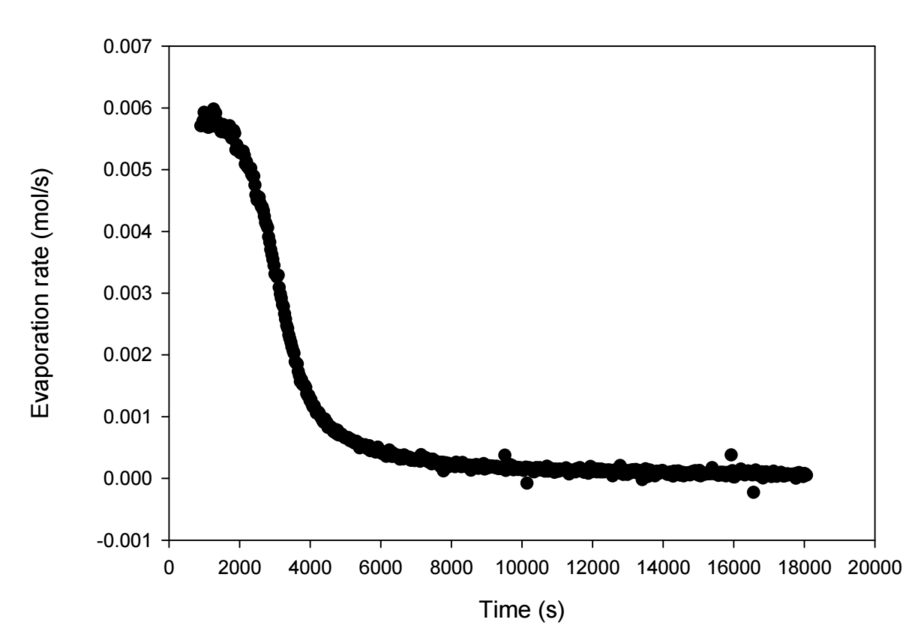Evapoporometry on:
[Wikipedia]
[Google]
[Amazon]
Evapoporometry is a method used to determine pore-size in

Evapore, an open-source Python tool for Evapoporometry data analysis.
synthetic membranes
An artificial membrane, or synthetic membrane, is a synthetically created membrane which is usually intended for separation purposes in laboratory or in industry. Synthetic membranes have been successfully used for small and large-scale industrial ...
. Based on the Kelvin equation
The Kelvin equation describes the change in vapour pressure due to a curved liquid–vapor interface, such as the surface of a droplet. The vapor pressure at a convex curved surface is higher than that at a flat surface. The Kelvin equation is de ...
, this technique is most accurate for detection of pore diameters between 4 nm to 150 nm.
Theory
Evapoporometry uses modified forms of the Kelvin equation to relate the evaporation of a wetting liquid (usually2-propanol
Isopropyl alcohol (IUPAC name propan-2-ol and also called isopropanol or 2-propanol) is a colorless, flammable organic compound with a pungent alcoholic odor. As an isopropyl group linked to a hydroxyl group (chemical formula ) it is the sim ...
) from a membrane to the average diameter of the pores in that membrane. The primary equation used in this technique is:
Where is the pore diameter, is the surface tension
Surface tension is the tendency of liquid surfaces at rest to shrink into the minimum surface area possible. Surface tension is what allows objects with a higher density than water such as razor blades and insects (e.g. water striders) to f ...
, is the vapor molar volume
In chemistry and related fields, the molar volume, symbol ''V''m, or \tilde V of a substance is the ratio of the volume occupied by a substance to the amount of substance, usually given at a given temperature and pressure. It is equal to the molar ...
, is the gas constant
The molar gas constant (also known as the gas constant, universal gas constant, or ideal gas constant) is denoted by the symbol or . It is the molar equivalent to the Boltzmann constant, expressed in units of energy per temperature increment per ...
, is the absolute temperature
Thermodynamic temperature is a quantity defined in thermodynamics as distinct from kinetic theory or statistical mechanics.
Historically, thermodynamic temperature was defined by Kelvin in terms of a macroscopic relation between thermodynamic wor ...
, is the instantaneous evaporation rate in , and is the average evaporation rate of the free-standing liquid layer in .

Method
Evapoporometry has the significant advantage of requiring only a lab scale, 2-propanol (or another wetting fluid), and a cell in which to contain the sample and 2-propanol. The sample is immersed for some time in 2-propanol prior to measurement to ensure saturation of pores, and is then placed into the cell in an analytical balance and immersed again in 2-propanol, after which the change in mass due to evaporation of the free-standing liquid layer and then draining of liquid from pores is measured by the analytical balance. Instantaneous evaporation rates are calculated from the mass data and input into the above equation to yield a pore-size distribution for the sample. can be used to quantitatively determine value of at which pore draining begins, which is equal to , where is the standard deviation of . This analysis is enabled by the principle that evaporation from small pores will only occur after 2-propanol in larger pores has completely evaporated. It is important to note that there exists a nanoscale layer of wetting fluid on both the membrane and the test cell material known as the "t-layer," the mass of which is to be excluded from measurement to increase accuracy, otherwise these points may be incorrectly attributed to subnanometer pores. Akhondi ''et al'' describe methods for correction of the t-layers of the test cell and membrane, as well as a correction for swelling of membranes during the experiment. The correction for the t-layer of the test cell itself can be made by performing the evapoporometry procedure as described above with an empty test cell, integrating from the start point of pore draining until the point at which = 4 nm to yield the mass of the t-layer. This mass plus the mass of the membrane's t-layer will constitute the endpoint of pore diameter calculation for the principal evapoporometry measurement.See also
*Synthetic membrane
An artificial membrane, or synthetic membrane, is a synthetically created membrane which is usually intended for separation purposes in laboratory or in industry. Synthetic membranes have been successfully used for small and large-scale industrial ...
* Porosimetry
Porosimetry is an Measurement, analytical technique used to determine various quantifiable aspects of a material's Porosity, porous structure, such as pore diameter, total pore volume, surface area, and Bulk density, bulk and absolute density, den ...
* Hollow fiber membrane
Hollow fiber membranes (HFMs) are a class of artificial membranes containing a semi-permeable barrier in the form of a hollow fiber. Originally developed in the 1960s for reverse osmosis applications, hollow fiber membranes have since become p ...
External links
Evapore, an open-source Python tool for Evapoporometry data analysis.
References
{{Reflist Polymers Polymer chemistry